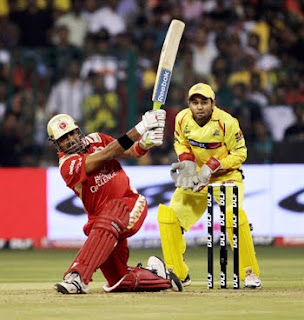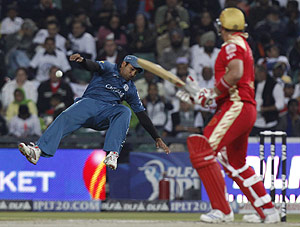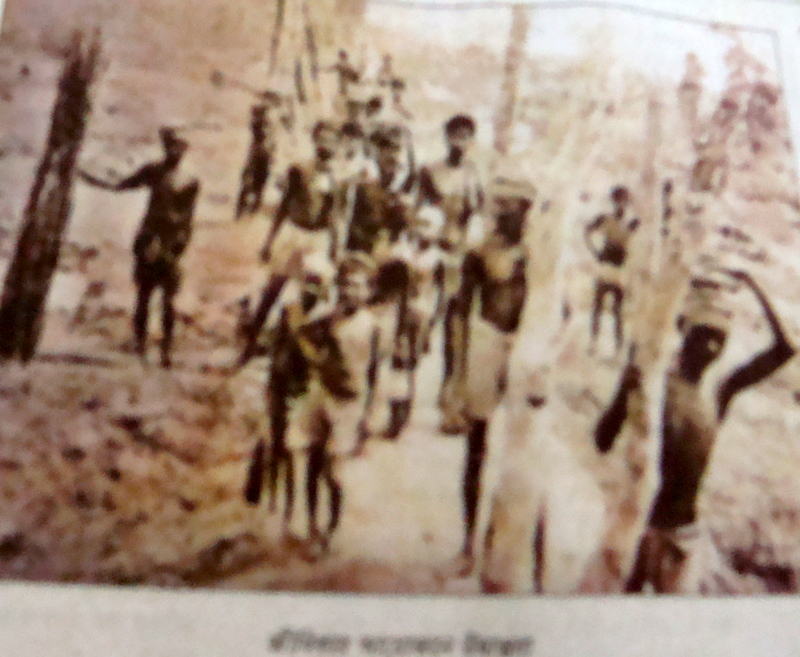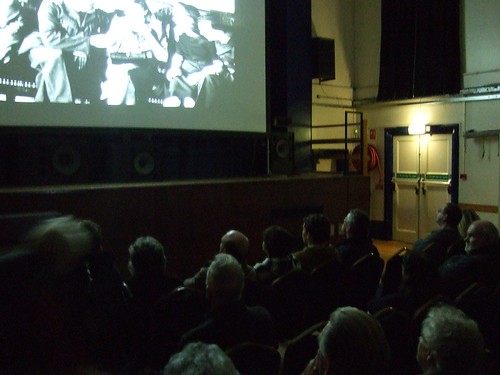
To all those celebrating LSD as the cult film of the decade, as the great pathbreaker in Indian Cinema, as a member of the Least Common Denominator—the paying public, I differ and differ vehemently. Duped by a National award winning label on Dibakar Banerjee’s Oye Lucky, Lucky Oye, and the hullabaloo made by National TV Channels and the big shot newspapers who were falling over themselves to eulogise the movie and more ,its director---I went to see the movie at a noonshow in a well known Central Kolkata Hall.

I was dampened by the sight of only 4 occupants in the Dress circle at Rs.80/ticket and hardly a hundred people in the hall.The hall was something like the above. From the beginning I was informed that we are all basically in front of various types of cameras and a participant in a reality show by Dee Bee enterprises. After a few minutes ,I was rubbing my eyes ,not in disbelief but in real pain as the story( more evident in its absence) evolved with jerkiness, deliberate hand held shakes and unfocussed. That , I was assured, was the New Age filmmaking—more real than skilled. Cinema , or the Cult Film Zamana is a director’s viewpoint and only that—the poor audience could always have a splitting headache—but that does not matter at all. Ekta Kapoor, the producer, screamed when she saw the preview. For once, I agreed with her. However she settled down as she realised that the 3 crores had already been spent. She refused however to show it to her parents.

The film evolved in three parts—Love—Sex and Dhoka. The Love part was a traditional spoof on a rich girl-poor boy love story, with an eager father getting a role in the film by a budding director making his diploma film. The poor director falls in love with the rich heroine and finally brother with his goons kill and bury them . An ad nauseum plot, made cleverly by juxtaposing film with reality, and moving front and back in style. However, the old DDLJ prevails(Simran and all that) and there is the tragic end of this part.
Sex then takes over and a manager of the firm is bent on taking a store attendant to bed as a challenge and then selling the clip for Rupees seventy thousand to a reality TV show!!!!


The great pataoing goes on and finally the girl agrees to a rendezvous in the store room!!!!The camera is framed to catch the VITAL moment. It turns out that the previous section “Love” protagonists are this girl’s friend. On learning of their death, the girl in a moment of emotional turmoil, clutches onto the male.The Moment arrives and the male protagonist is allowed to do his act which he does staring at the camera. Thank God, the censors pixellated the scene as this alone might just have made this film popular (that of course was the director’s intent…)The clip is sold, rages as a superhit, and invades the mobile denizens. The girl wants to commit suicide. The thread continues in the third part as a girl attempting suicide is saved by a person who has already failed in an attempt to do the same.


The third part is called DHOKA. Here the rescued girl and this cameraman run a sting operation for the Reality TV company. They trap the victim, an aging pop star, on camera talking about sex for work. They are finally re instructed to film the victim giving them money. After a confused rigmarole, all the three couples are seen in a stylised finale of being Reality TV participants.
Unfortunately, we felt that the Dhoka is all that we were left with as we lurched out of the hall.
The film goes forward and back and laterally as the main characters twine and intertwine between the three sections. “Inspired” by the real life incidences like the Delhi MMS scandal, the intercaste/inter status marriages and their violent sequelae to retain honour and the sting operation phenomenon that sweeps the country now and then—the film is cleverly constructed. DB cocks a snook at the establishment and with racy editing, pushes the film to an ending.
However as a member of the paying public, there were too many inconsistencies which could not be glazed over by the glossiness and pace.
Was there a story of any merit anywhere? No, not at all. The plot is hackneyed and predictable and seen before in Dev D and the bad “Reconstructions” in TV channels. Was the concept of the camera playing all the time, unique ? No, it was irritating, never allowed the viewer to watch the film with any degree of ease and seen before in Paranormal. Maybe DB wanted the film to make his audience feel disturbed? This disturbance is not of any social value. We have felt disturbed by Pather Panchali on one side or Satya or Rang De Basanti or Paa or My Name is Khan on the other. But those were positive disturbances which made us think and react. Here the effect is trying to forget it as fast as possible!!! Here the film is irritating and obnoxious, the feeling of being taken for a ride and duped of our hard earned money by a director who wants to snigger at the Industry and the traditional methods of films. It is really unfair that we have to finance DB’s personal quirks and also have a splitting headache and eyeache in the bargain.
The critics will love the movie as it provides a break from tradition. Unfortunately, the ordinary viewer goes to see a film with certain expectations. Not all the time do we go for Time Pass entertainment. We go to be stirred, emotionally and creatively, willing and wanting to appreciate art and creativity, not only for gloss and glamour. We do unfortunately have our own views derived from our own intelligence (surprise for our all knowing directors—we can actually think!!!). So when a director thinks that we can be walked over by oversmartness and mis experimentation—he is in for a surprise. If he disregards our sentiments, he will find acclaim from select interested groups, but not at the box office and hopefully not from any producer who values his money.
Wikipedia informs us thus. The film has been critically acclaimed by the movie reviewers for its unique filming style, acting, realistic story and superb editing.
Taran Adarsh of Bollywood Hungama reviewed positively saying, "On the whole, Love Sex aur Dhokha is original, innovative and ground-breaking cinema, which will shock and provoke you. The film is definitely not for the faint-hearted or those who swear by stereotypical fares, but for those who yearn for a change." and rated it 4 out of 5 stars..
Rajeev Masand of CNN IBN rated it 4 out of 5, stating "Dibakar Banerjee's Love, Sex aur Dhoka is the most riveting Hindi film in recent memory. [...] You will be shocked, you will be startled, but walking out of the theatre, you know you have just seen what is possibly the most important Hindi film since Satya and Dil Chahta Hai. Not only does it redefine the concept of "realistic cinema", it opens a world of possibilities in terms of how you can shoot films now."
Subhash Jha of Bollywood Hungama critically criticised the film stating, "The film never belittles or sentimentalizes the characters' lack of choices. While inventing a unique format of cinematic expression Dibakar Banerjee has not emotionally emasculated the characters. [...] In terms of technique this film gets as rough and jolting as any film can. The actors look like reality-show rejects making a last-bid attempt to prove their worth." .
Martin D'Souza of film portal glamsham.com rated it 4 out of 5 and verdict, "What is very smart is the way Banerjee weaves the lives of all three couples to make it one smart movie. At first, it appears as three separate issues but the end surprises. Intelligent cinema. It real and it's scary."
Sarita Tanwar of Mid Day, gives it a 4 and a half out of 5 and stated, " LSD has all the makings of a contemporary cult classic this season's best film. It's a must-watch.
Gaurav Malani of India Times gives it a four out of five, and stated, "At several levels, Love Sex aur Dhokha is at par with some of the best titles in world cinema in terms of its treatment."
Nikhat Kazmi of Times of India gave a three and a half to the film, and stated, "Don't expect time-pass entertainment. Think beyond run-of-the-mill and see how Ekta Kapoor re-invents herself as the producer of contemporary Indian cinema's first full-blown experimental film.
Raja Sen, of web portal Rediff.com, gives it a perfect five, and stated "It's bleak, bittersweet, funny and markedly unglamorous, and yet you come out humming the theme tune, your head blown clear off your shoulders.
Mayank Shekhar of Hindustan Times gives it a three and half, and stated, it as " truly an experiment" in Bollywood.
The final comment however is reserved for us –the audience.
“The film has done below average performance at the box office, with it's targeted multiplex audience not reaching to the expectation.” ( www.boxofficeindia.com).
And rightly so. Forgettable music, oft repeated theme, reality show acting as bad as it can get, boring, gimmicky, tiring and repeatedly irritating, portraying a small aberrant portion of society with a prominence it did not deserve, descending to cheap titillation from the title, dialogue and lyrics in an attempt to cover up for creative deficiencies, promoting voyeurism as a way of life, and disregarding audience likings for a critics review bonanza—this film will of course crash resoundingly at the Box Office.
But does DB care? Watch this movie only if you feel like sponsoring this tiresome DB snigger at Bollywood!!!

























































